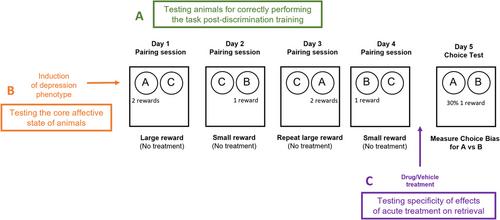下载PDF
{"title":"The Affective Bias Test and Reward Learning Assay: Neuropsychological Models for Depression Research and Investigating Antidepressant Treatments in Rodents","authors":"Justyna K. Hinchcliffe, Emma S. J. Robinson","doi":"10.1002/cpz1.1057","DOIUrl":null,"url":null,"abstract":"<p>The Affective Bias Test (ABT) quantifies acute changes in affective state based on the affective biases they generate in an associative reward learning task. The Reward Learning Assay (RLA) provides a control assay for the ABT and reward-induced biases generated in this model are sensitive to changes in core affective state. Both tasks involve training animals to associate a specific digging substrate with a food reward. Animals learn to discriminate between two digging substrates placed in ceramic bowls, one rewarded and one unrewarded. In the ABT, the animal learns two independent substrate-reward associations with a fixed reward value following either an affective state or drug manipulation, or under control conditions. Affective biases generated are quantified in a choice test where the animals exhibit a bias (make more choices) for one of the substrates which is specifically related to affective state at the time of learning. The ABT is used to investigate biases generated during learning as well as modulation of biases associated with past experiences. The RLA follows a similar protocol, but the animal remains in the same affective state throughout and a reward-induced bias is generated by pairing one substrate with a higher value reward. The RLA provides a control to determine if drug treatments affect memory retrieval more generally. Studies in depression models and following environmental enrichment suggest that reward-induced biases are sensitive to core changes in affective state. Each task offers different insights into affective processing mechanisms and may help improve the translational validity of animal studies and benefit pre-clinical drug development. © 2024 The Authors. Current Protocols published by Wiley Periodicals LLC.</p><p><b>Basic Protocol 1</b>: Bowl digging and discrimination training</p><p><b>Basic Protocol 2</b>: The reward learning assay</p><p><b>Basic Protocol 3</b>: The affective bias test - new learning</p><p><b>Basic Protocol 4</b>: The affective bias test - modulation of affective biases associated with past experiences</p>","PeriodicalId":93970,"journal":{"name":"Current protocols","volume":"4 6","pages":""},"PeriodicalIF":0.0000,"publicationDate":"2024-06-26","publicationTypes":"Journal Article","fieldsOfStudy":null,"isOpenAccess":false,"openAccessPdf":"https://onlinelibrary.wiley.com/doi/epdf/10.1002/cpz1.1057","citationCount":"0","resultStr":null,"platform":"Semanticscholar","paperid":null,"PeriodicalName":"Current protocols","FirstCategoryId":"1085","ListUrlMain":"https://onlinelibrary.wiley.com/doi/10.1002/cpz1.1057","RegionNum":0,"RegionCategory":null,"ArticlePicture":[],"TitleCN":null,"AbstractTextCN":null,"PMCID":null,"EPubDate":"","PubModel":"","JCR":"","JCRName":"","Score":null,"Total":0}
引用次数: 0
引用
批量引用
Abstract
The Affective Bias Test (ABT) quantifies acute changes in affective state based on the affective biases they generate in an associative reward learning task. The Reward Learning Assay (RLA) provides a control assay for the ABT and reward-induced biases generated in this model are sensitive to changes in core affective state. Both tasks involve training animals to associate a specific digging substrate with a food reward. Animals learn to discriminate between two digging substrates placed in ceramic bowls, one rewarded and one unrewarded. In the ABT, the animal learns two independent substrate-reward associations with a fixed reward value following either an affective state or drug manipulation, or under control conditions. Affective biases generated are quantified in a choice test where the animals exhibit a bias (make more choices) for one of the substrates which is specifically related to affective state at the time of learning. The ABT is used to investigate biases generated during learning as well as modulation of biases associated with past experiences. The RLA follows a similar protocol, but the animal remains in the same affective state throughout and a reward-induced bias is generated by pairing one substrate with a higher value reward. The RLA provides a control to determine if drug treatments affect memory retrieval more generally. Studies in depression models and following environmental enrichment suggest that reward-induced biases are sensitive to core changes in affective state. Each task offers different insights into affective processing mechanisms and may help improve the translational validity of animal studies and benefit pre-clinical drug development. © 2024 The Authors. Current Protocols published by Wiley Periodicals LLC.
Basic Protocol 1 : Bowl digging and discrimination training
Basic Protocol 2 : The reward learning assay
Basic Protocol 3 : The affective bias test - new learning
Basic Protocol 4 : The affective bias test - modulation of affective biases associated with past experiences
情感偏差测试和奖赏学习测试:用于抑郁症研究和啮齿动物抗抑郁治疗调查的神经心理学模型。
情感偏差测试(ABT)根据在联想奖赏学习任务中产生的情感偏差来量化情感状态的急性变化。奖赏学习试验(RLA)为 ABT 提供了一种对照试验,该模型中产生的奖赏诱导偏差对核心情感状态的变化非常敏感。这两项任务都是训练动物将特定的挖掘基质与食物奖励联系起来。动物学会分辨放在陶瓷碗中的两种挖掘底物,一种是有奖励的,另一种是没有奖励的。在 ABT 中,动物在情感状态或药物操作后,或在控制条件下,学习两个独立的基质与固定奖励值的奖励关联。在选择测试中,动物会对其中一种底物表现出偏向(做出更多选择),而这种偏向与学习时的情绪状态特别相关。ABT 用于研究学习过程中产生的偏差以及与过去经验相关的偏差调节。RLA 遵循类似的协议,但动物在整个过程中保持相同的情绪状态,并通过将一种底物与较高价值的奖励配对来产生奖励诱导的偏差。RLA 为确定药物治疗是否会更普遍地影响记忆检索提供了对照。在抑郁模型和环境富集后进行的研究表明,奖励诱导偏差对情感状态的核心变化非常敏感。每项任务都对情感处理机制提供了不同的见解,可能有助于提高动物研究的转化有效性,并有利于临床前药物开发。© 2024 作者。当前协议》由 Wiley Periodicals LLC 出版。基本方案 1:挖碗和辨别训练 基本方案 2:奖励学习测定 基本方案 3:情感偏差测试--新学习 基本方案 4:情感偏差测试--调节与过去经历相关的情感偏差。
本文章由计算机程序翻译,如有差异,请以英文原文为准。


